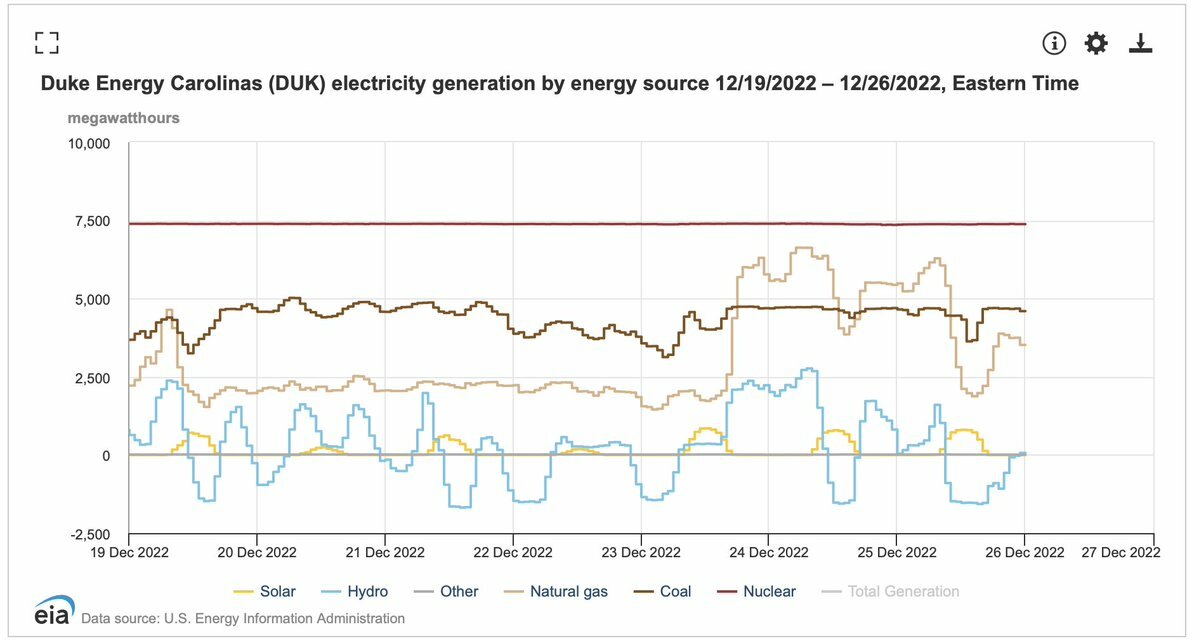In the past week, Duke Energy systematically shut down parts of the North Carolina and South Carolina power grid in what the utility described as an effort to stabilize energy usage during bitter cold holiday temperatures. Called “rolling blackouts,” the strategy raised a red flag for public officials and energy policy experts after tens of thousands of customers were without power during Christmas weekend, reportedly not notified ahead of time.
“Due to extreme cold weather causing increased demand and a shortage of available power in the Southeast region, the company was forced to interrupt service to about 500,000 customers to maintain the energy grid and prevent further disruptions,” Duke Energy reported on Christmas Day.
On Wednesday, the power is now back on for the thousands of people who went without electricity at times over the holiday. As recently as Tuesday morning, according to Duke’s outage map, there were still 1,600 homes without power across North Carolina, primarily in the Triangle, Charlotte, and Greensboro areas.
Gov. Roy Cooper is asking Duke Energy for an account of what happened.
“I’m thrilled to hear that Governor Cooper asked Duke Energy, ‘what went wrong.’” said Amy Cooke, CEO of the John Locke Foundation. “My hope is that Duke is honest with him. The explanation is simple. Electricity demand was higher than supply. Rolling blackouts are the consequence of the Governor’s policy that forces more unreliable power sources on our grid and prohibits the expansion of natural gas infrastructure.”
The outages lasted throughout the Christmas weekend, with Duke Energy reporting Monday that operations are back to normal.
“Duke Energy has met today’s expected peak energy demand in the Carolinas, thanks in part to customer efforts to conserve power after the weekend’s arctic blast affecting power generation and delivery in much of the country,” Duke Energy of the Carolinas wrote in a statement. “As a result of gradually warming temperatures and improved power availability, no additional conservation measures are needed from customers at this time.”
However, energy policy experts say that Duke’s “conservation measures” highlight the fragility of the state’s power grid. Reports indicate that increased focus on renewable energy has diverted resources and focus away from shoring up the existing grid to ensure safety, security, and reliability.
A study from the North American Electric Reliability Cooperation found that, if the power grid becomes dependent on solar and wind, a simple chain of cloudy days could turn the power off for thousands of homes. An extreme cold snap or increased demand like the one over the Christmas holiday would wreak havoc. The graph below shows the output of different energy sources, along with demand, over the week of Christmas. Coal and nuclear are the primary sources during that period.

“Wind and solar are making the grid more unreliable as they gain share,” the NERC report read in July 2022.
The Institute for Energy Research also warned of growing disruptions back in the summer of 2022, as usage spiked during remote work and shutdowns.
“The duration of operator-initiated load shedding events spiked, and unserved energy demand reached its highest levels ever,” their report read. “No longer is peak demand the only clear risk to reliability — risks can emerge when weather-dependent generation is impacted by abnormal atmospheric conditions or when extreme conditions disrupt fuel supplies.”
Duke Energy’s rolling blackouts over Christmas come just weeks after vandals shot up a substation in Moore County on Dec. 7, plunging 45,000 homes and businesses across the region into darkness during peak shopping season. The attackers in that case have not been arrested, but questions remain about not just the reliability of the state’s power grid, but the security of each link in the chain of power to homes. The vulnerabilities in the grid highlighted this month by the attack and the cold snap indicate that a shift of focus in energy policy could be on the horizon.
“The biggest problem is we can’t just turn up the wind turbines and solar panels to meet increased demand,” said Cooke. “During the arctic cold, solar power was nonexistent. Nuclear and coal served as the workhorses and natural gas increased, but it still wasn’t enough to meet demand. Cooper won’t allow expansion of natural gas infrastructure. So, as more and more people move to our state, rolling blackouts will continue at times of high demand. The fault lies with elected officials and the energy policy they push to satisfy special interest groups.”
This story was updated Wednesday December 28, 2022 with the most recent power outage numbers.